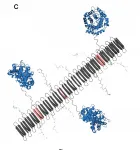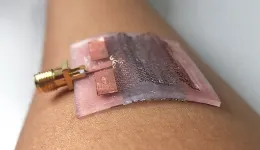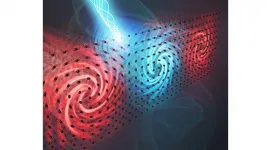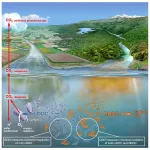(Press-News.org) Biomedical engineers at Duke University have developed a self-assembling nanomaterial that can help limit damage caused by inflammatory diseases by activating key cells in the immune system. In mouse models of psoriasis, the nanofiber-based drug has been shown to mitigate damaging inflammation as effectively as a gold-standard therapy.
One of the hallmarks of inflammatory diseases, like rheumatoid arthritis, Crohn's disease and psoriasis, is the overproduction of signaling proteins, called cytokines, that cause inflammation. One of the most significant inflammatory cytokines is a protein called TNF. Currently, the best treatment for these diseases involves the use of manufactured antibodies, called monoclonal antibodies, which are designed to target and destroy TNF and reduce inflammation.
Although monoclonal antibodies have enabled better treatment of inflammatory diseases, the therapy is not without its drawbacks, including a high cost and the need for patients to regularly inject themselves. Most significantly, the drugs also have uneven efficacy, as they may sometimes not work at all or eventually stop working as the body learns to make antibodies that can destroy the manufactured drug.
To circumvent these issues, researchers have been exploring how immunotherapies can help teach the immune system how to generate its own therapeutic antibodies that can specifically limit inflammation.
"We're essentially looking for ways to use nanomaterials to induce the body's immune system to become an anti-inflammatory antibody factory," said Joel Collier, a professor of biomedical engineering at Duke University. "If these therapies are successful, patients need fewer doses of the therapy, which would ideally improve patient compliance and tolerance. It would be a whole new way of treating inflammatory disease."
In their new paper, which appeared online in the Proceedings of the National Academy of Sciences on April 5, Collier and Kelly Hainline, a graduate student in the Collier lab, describe how novel nanomaterials could assemble into long nanofibers that include a specialized protein, called C3dg. These fibers then were able to activate immune system B-cells to generate antibodies.
"C3dg is a protein that you'd normally find in your body," said Hainline. "The protein helps the innate immune system and the adaptive immune system communicate, so it can activate specific white blood cells and antibodies to clear out damaged cells and destroy antigens."
Due to the protein's ability to interface between different cells in the immune system and activate the creation of antibodies without causing inflammation, researchers have been exploring how C3dg could be used as a vaccine adjuvant, which is a protein that can help boost the immune response to a desired target or pathogen.
In their new nanomaterial, Hainline and Collier were able put this idea to the test by weaving key fragments of the C3dg protein with components of TNF into nanofibers. The C3dg protein would trigger the B-cells to create antibodies, while the TNF components would provide a blueprint of what the antibodies need to seek out and destroy.
"When Kelly assembled the C3dg protein and key portions of TNF into these nanofibers, she saw that there was a strong B-cell response, which means there was an increased production of antibodies that targeted TNF," said Collier. "In standard mouse models of inflammation, mice experience a temperature change where their internal temperature will drop. But when Kelly delivered her C3dg nanofibers, it was highly protective, and the mice didn't experience an inflammatory response."
When the team tested their nanomaterial in the psoriasis mouse model, they found that the nanofibers carrying C3dg were as effective as a monoclonal antibody therapy. And because C3dg is normally found in the body, it wasn't flushed out of the system by anti-drug antibodies.
After examining the psoriasis model, the team made a surprising discovery -- C3dg wasn't just stimulating antibody production in the B-cells, it was also influencing the response of T-cells.
"We observed that nanofibers that only contained the C3dg components without the TNF components still showed a therapeutic benefit to our models, which was surprising. But I think the most significant discovery was seeing a beneficial T-cell response that was activated by a protein you'd naturally find in your body," said Hainline. "That kind of response had been seen before with other proteins, but we haven't seen any reports of people using that response with C3dg."
For their next steps, the team hopes to further explore the mechanisms behind this beneficial T-cell activation. They'll also pursue additional experiments to explore the response to similar nanomaterials in rheumatoid arthritis models.
"We're still learning about this T-cell response, and we're trying to understand how it's involved," said Collier. "Ultimately, we'd love to see if C3dg can be used as a universal component in multiple different therapies against inflammation, especially if we can swap out the TNF segments with a different target. This work clearly indicates that nanomaterials involving C3dg warrant further development as immunotherapies."
INFORMATION:
This research was funded by the National Institutes of Health (NIBIB 5R01EB009701) and Duke University, an NIH Training Grant (T32GM008555), the NSF Graduate Research Fellowship Program (DGE-1644868), and the North Carolina Biotechnology Center (2017-IDG-1018)
CITATION: "Modular Complement Assemblies for Mitigating Inflammatory Conditions,"Kelly Hainline, Lucas Shores, Nicole Votaw, Zachary Bernstein, Sean Kelly, Chelsea Fries, Marisha Madhira, Caslin Gilroy, Ashutosh Chilkoti, Joel Collier. Proceedings of the National Academy of Sciences, April 5, 2021. DOI 10.1073/pnas.2018627118
Current research on flexible electronics is paving the way for wireless sensors that can be worn on the body and collect a variety of medical data. But where do the data go? Without a similar flexible transmitting device, these sensors would require wired connections to transmit health data.
Huanyu "Larry" Cheng, Dorothy Quiggle Career Development Assistant Professor of Engineering Science and Mechanics in the Penn State College of Engineering, and two international teams of researchers are developing devices to explore the possibilities of wearable, flexible antennae. They published two papers in April in Nano-Micro Letters and Materials & Design.
Wearable antenna bends, ...
Biological energy flows, such as in photosynthesis and respiration, depend on the transfer of electrons from one molecule to another. Despite its importance to sustaining life, factors governing the rate of electron transfer, especially over long distances, are not well understood because the systems that mediate such ultrafast processes are very complex. A better understanding of electron transfer rates would help scientists improve chemical transformations, energy conversion, electronic devices, and photonic technologies.
Now, an international team of researchers led by UC Riverside has observed picosecond charge transfer mediated by hydrogen bonds in peptides. A picosecond is one trillionth of a second. ...
The coronavirus pandemic has led researchers to switch gears or temporarily abandon projects due to health protocols or not being able to travel. But for Patrick Keys and Elizabeth Barnes, husband and wife scientists at Colorado State University, this past year led to a productive research collaboration.
They teamed up with Neil Carter, assistant professor at the University of Michigan, on a paper published in END ...
As older teens and young adults become eligible for COVID-19 vaccination across the country, and younger teens await their turn, new survey data suggest a strong readiness that has grown since fall.
But just as with older generations, a shrinking but still sizable minority of people age 14 to 24 say they're not willing to get vaccinated, or that their decision will depend on safety.
That makes it crucial for public health authorities, health care providers and others to create vaccination-related materials that reach young people in ways that are relevant to them.
The data, from the text-message-based END ...
Our high-speed, high-bandwidth world constantly requires new ways to process and store information. Semiconductors and magnetic materials have made up the bulk of data storage devices for decades. In recent years, however, researchers and engineers have turned to ferroelectric materials, a type of crystal that can be manipulated with electricity.
In 2016, the study of ferroelectrics got more interesting with the discovery of polar vortices -- essentially spiral-shaped groupings of atoms -- within the structure of the material. Now a team of researchers led by the U.S. Department of Energy's (DOE) Argonne National Laboratory has uncovered new insights into the behavior of these vortices, insights that may be the first step toward using them for ...
A new study has identified a strong correlation between changes in Taiwan's seismicity rate and its seasonal water cycle fluctuations, suggesting that many faults in this region are so stressed that even minor shifts in strain caused by changes in groundwater storage can trigger earthquakes. Ya-Ju Hsu and colleagues observed that western Taiwan's seismicity rate reaches its highest levels between February and April, when the crust rebounds as stress from the groundwater load decreases, and its seismicity reaches its lowest levels between July and September, at the tail end of monsoon season. However, the researchers ...
COVID-19 and hemorrhagic stroke are a deadly combination, increasing the risk of death up to 2.4 times among patients who have this pairing compared to those who only had hemorrhagic strokes, according to a nationwide study led by University of Utah Health scientists. Patients who survived had longer hospital stays, more medical complications, and less favorable outcomes than those who did not have both conditions.
Racial and ethnic minorities and those who were obese or had diabetes were among the most vulnerable.
"This is one of the first studies to document that, in patients with hemorrhagic stroke who have comorbid COVID-19, there is a significantly elevated risk of in-hospital death," says Adam de Havenon, M.D., senior author of the study and an assistant professor of neurology ...
When wastewater from villages and cities flows into rivers and lakes, large quantities of fats, proteins, sugars and other carbon-containing, organic substances wind up in nature together with the fecal matter. These organic substances are broken down by bacteria that consume oxygen. The larger the volume of wastewater, the better the bacteria thrive. This, however, means the oxygen content of the water continues to decrease until finally the fish, muscles or worms literally run out of air. This has created low-oxygen death zones in many rivers and lakes around the world.
No gold standard for measurements until now
In order to measure how heavily the waters are polluted with organic matter from feces, government ...
Grave goods, such as stone tools, have revealed that Neolithic farmers had different work-related activities for men and women.
Researchers at the University of York analysed 400 stone objects found in graves at cemetery sites across Europe and noted there were differences in size, weight, and raw material dependent on whether the body was a male or a female.
Archaeologists had previously thought that polished stone tools in this period were used for woodworking, but analysis now shows a much wider range of tasks, with different activities for men and women.
The tools found in female graves were most likely used for the working of animal skins and hide, and tools for the men were associated with hunting ...
Researchers at HSE University have identified the genes that play a crucial role in breast cancer metastasis. The results of the study were published in the journal PLOS ONE.
Every human cell includes a huge number of various molecules: DNA, RNA, proteins, etc. One of the essential classes of molecules that interact with each other are microRNAs, along with their target genes and transcription factors. MicroRNAs are small molecules, which can directly reduce the concentration (expression) of target genes, while transcription factors are able to both increase and reduce the expression of ...





